Introduction
Asus unveiled a handful of new devices at its CES 2014 press conference, making it one of the most action packed events this year in Las Vegas. Three new Android-powered smartphones premiered as part of the brand new Zenfone lineup. There is another PadFone on the way as well. Plus the Asus Transformer Book Duet, which is quite intriguing for laptop and tablet enthusiasts.
So, the new Zenfone lineup is made up of three interesting droids - the 4" Zenfone 4, the 5" Zenfone 5 and the 6" Zenfone 6 phablet. Yes, there is a size for everyone here. Let's take a closer look at the Zenfones' features.
Asus Zenfone 4 at a glance
- Dimensions: 124.4 x 61.4 x 11.2mm, 115g
- Display: 4.0" LED-backlit IPS display of WVGA resolution, 233ppi
- Chipset: Intel Atom Z2520; dual-core Intel Atom at 1.2GHz, PowerVR SGX 544MP2 GPU, 1GB RAM
- OS: Android 4.3 Jelly Bean (planned upgrade to 4.4 KitKat), Asus Zen UI
- Camera: 5MP, autofocus, front-facing camera
- Storage: 4GB built-in, microSD card slot
- Connectivity: Dual-SIM, HSPA+, GPS, WLAN b/g/n, microUSB 2.0, Bluetooth 4.0 LE
- Battery: 1,170mAh, Li-Po, removable
- Misc: built-in accelerometer, multi-touch input, proximity sensor
- Colors: Black, White, Red, Blue, Yellow

Asus Zenfone 5 at a glance

- Dimensions: 148.2 x 72.8 x 10.3mm, 140g
- Display: 5.0" LED-backlit IPS display of 720p resolution, 294ppi
- Chipset: Intel Atom Z2580; dual-core Intel Atom at 2GHz, PowerVR SGX 544MP2 GPU, 1GB RAM
- OS: Android 4.3 Jelly Bean (planned upgrade to 4.4 KitKat), Asus Zen UI
- Camera: 8MP, autofocus, LED flash, 2MP front-facing camera
- Storage: 4GB built-in, microSD card slot
- Connectivity: Dual-SIM, HSPA+, GPS, WLAN b/g/n, microUSB 2.0, Bluetooth 4.0 LE
- Battery: 2,050mAh, Li-Po, non-removable
- Misc: built-in accelerometer, multi-touch input, proximity sensor
- Colors: Black, White, Red, Blue, Gold

Asus Zenfone 6 at a glance
- Dimensions: 166.9 x 84.3x 9.9mm, 200g
- Display: 6.0" LED-backlit IPS display of 720p resolution, 244ppi
- Chipset: Intel Atom Z2580; dual-core Intel Atom at 2GHz, PowerVR SGX 544MP2 GPU, 1GB RAM
- OS: Android 4.3 Jelly Bean (planned upgrade to 4.4 KitKat), Asus Zen UI
- Camera: 13MP, autofocus, LED flash, 2MP front-facing camera
- Storage: 8/16 GB built-in, microSD card slot
- Connectivity: Dual-SIM, HSPA+, GPS, WLAN b/g/n, microUSB 2.0, Bluetooth 4.0 LE
- Battery: 3,230mAh, Li-Po, non-removable
- Misc: built-in accelerometer, multi-touch input, proximity sensor
- Colors: Black, White, Red, Gold
- he other two devices announced at CES are the AT&T exclusive Asus Padfone X - a hybrid device consisting of a 5" 1080p smartphone and an optional 9" 1080p tablet dock, plus the intriguing Macbook-clone, the Transformer Book.We spent some quality time with all of these last night and we are ready to share our first impressions with you. The tour begins right after the jump
Asus Zenfone 4 hands-on
The Asus Zenfone 4 is the smallest and most affordable member of the new Zenfone lineup. It comes with a 4″ WVGA IPS display and runs on a dual-core Intel Atom Z2520 1.2GHz processor. The rest of the specs include PowerVR SGX 544MP2 graphics, 1GB of RAM, 4GB of expandable storage and Android 4.3 Jelly Bean. Asus says the phone will be launching with Android 4.3 Jelly Bean but will be getting KitKat shortly after.The Zenfone 4 is made entirely of matte plastic and is a bit thicker compared to its siblings. It is a dual-SIM device with a snappy chipset at a bargain price, so we are ready to forgive it the extra few millimeters around the waiste.The entire front is occupied by the 4.0-inch IPS WVGA display with the typical Android capacitive controls below. The lonely camera lens is on the matte black, there is no LED flash.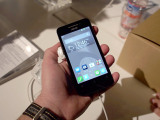
 Asus Zenfone 4The battery cover is removable and you can access the two SIM beds, the microSD slot and the battery whenever you want. In case you don't like the black flavor, Asus will be offering white, red, blue and yellow colors as well.The right side of the Asus Zenfone 4 has the glossy Power/Lock key and the volume rocker, while the left one houses the microUSB connectivity/charging port.
Asus Zenfone 4The battery cover is removable and you can access the two SIM beds, the microSD slot and the battery whenever you want. In case you don't like the black flavor, Asus will be offering white, red, blue and yellow colors as well.The right side of the Asus Zenfone 4 has the glossy Power/Lock key and the volume rocker, while the left one houses the microUSB connectivity/charging port.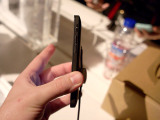
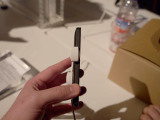 The Zenfone 4 right and left sidesThe 3.5mm audio jack is on top of the Zenfone 4, while the microphone pinhole is the only thing of interest at the bottom of the device.
The Zenfone 4 right and left sidesThe 3.5mm audio jack is on top of the Zenfone 4, while the microphone pinhole is the only thing of interest at the bottom of the device.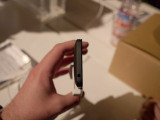
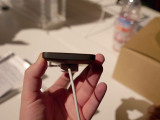 The top and bottom of the Zenfone 4The smartphone should cost just $99 SIM free and should launch in the coming months.
The top and bottom of the Zenfone 4The smartphone should cost just $99 SIM free and should launch in the coming months.Asus Zenfone 5 hands-on
The Asus Zenfone 5 is the second smartphone in the company’s latest Zenfone trio. As the name suggests, the handset comes with a 5″ screen, which is a 720p unit of the IPS+ variety. The smartphone runs on the fastest available Intel chipset – the Atom Z2580, which gives you a dual-core 2.0GHz Atom processor with hyper-threading, PowerVR SGX 544MP2 graphics and 1GB of RAM.The Zenfone 5, just like the other two Zenfones, is a dual-SIM device. The rest of its highlights include 4, 8 or 16 GB expandable storage, an 8MP Sony BSI rear camera and Android 4.3 Jelly Bean with a KitKat update in the pipeline.
 Asus Zenfone 5The design of the Asus Zenfone 5 is pretty much the same as the smaller Zenfone 4, it’s just a bit taller and wider and slightly thinner. Its rear is covered with a ceramic coating which is quite pleasant to the touch.The Zenfone 5′s front is the usual affair – a 2MP front snapper, an earpiece and a couple of sensors above the 5" display, plus the capacitive Android deck below the screen.
Asus Zenfone 5The design of the Asus Zenfone 5 is pretty much the same as the smaller Zenfone 4, it’s just a bit taller and wider and slightly thinner. Its rear is covered with a ceramic coating which is quite pleasant to the touch.The Zenfone 5′s front is the usual affair – a 2MP front snapper, an earpiece and a couple of sensors above the 5" display, plus the capacitive Android deck below the screen.

 Zenfone 5's frontThe 8MP camera and its LED flash companion are at the back. The huge loudspeaker grille is also around.
Zenfone 5's frontThe 8MP camera and its LED flash companion are at the back. The huge loudspeaker grille is also around. The back of Zenfone 5There is nothing on the left of the device, while the Power/Lock key and the volume rocker are on the right.
The back of Zenfone 5There is nothing on the left of the device, while the Power/Lock key and the volume rocker are on the right.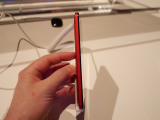
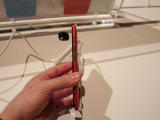 A peek at the left and right sides of the Zenfone 5Finally, the 3.5mm audio jack is on top, while the microphone pinhole and the microUSB port are at the bottom of the Zenfone 5.
A peek at the left and right sides of the Zenfone 5Finally, the 3.5mm audio jack is on top, while the microphone pinhole and the microUSB port are at the bottom of the Zenfone 5.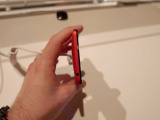
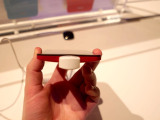 The 3.5mm audio jack is on top • the microUSB port at the bottomThe Asus Zenfone 5 will launch in Black, White, Blue, Red and Gold in the next couple of months starting at $149.
The 3.5mm audio jack is on top • the microUSB port at the bottomThe Asus Zenfone 5 will launch in Black, White, Blue, Red and Gold in the next couple of months starting at $149.Asus Zenfone 6 hands-on
The Asus Zenfone 6 is the biggest device in the lineup. It comes with a 6" IPS 720p display and runs on the same Intel Atom Z2580 chipset as the Zenfone 5.As we mentioned before, all Zenfones are dual-SIM devices, and the Zenfone 6 phablet makes no exception. The rest of the specs include a 13MP rear camera, 8 or 16GB expandable storage, and a massive 3,200 mAh battery.In case you've missed our Zenfone 5 hands-on, the Intel Atom Z2580 chipset offers two Atom cores ticking at 2GHz and capable of hyper-threading, PowerVR SGX544 MP2 GPU and 2GB of RAM.

 Asus Zenfone 6The Zenfone 6 is basically an enlarged Zenfone 5 and the only differences are the bigger screen (though at the same 720p resolution), and the higher-resolution 13MP camera sensor. The design is exactly the same, so is the layout of controls.Naturally, the capacitive controls are below the screen, while the front-facing 2MP camera and the earpiece are above the IPS display.
Asus Zenfone 6The Zenfone 6 is basically an enlarged Zenfone 5 and the only differences are the bigger screen (though at the same 720p resolution), and the higher-resolution 13MP camera sensor. The design is exactly the same, so is the layout of controls.Naturally, the capacitive controls are below the screen, while the front-facing 2MP camera and the earpiece are above the IPS display.
 A peek above and below the screenThe 13MP Panasonic SmartFSI sensor and its LED flash are at the back plus the loudspeaker grille at the bottom.Just like the Zenfone 5, the Zenfone 6's left side is completely bare. The Power/Lock key and the volume rocker are on the right.
A peek above and below the screenThe 13MP Panasonic SmartFSI sensor and its LED flash are at the back plus the loudspeaker grille at the bottom.Just like the Zenfone 5, the Zenfone 6's left side is completely bare. The Power/Lock key and the volume rocker are on the right.
 The left and right sides of the Zenfone 6Our tour ends with the top and bottom sides of the Zenfone 6, where we find the 3.5mm audio port and the microUSB port.
The left and right sides of the Zenfone 6Our tour ends with the top and bottom sides of the Zenfone 6, where we find the 3.5mm audio port and the microUSB port.
 Zenfone 6's top and bottom sidesThe Asus Zenfone 6 will hit the shelves soon and will start at $199. It will be available in Black, White, Red, and Gold flavors.
Zenfone 6's top and bottom sidesThe Asus Zenfone 6 will hit the shelves soon and will start at $199. It will be available in Black, White, Red, and Gold flavors.Asus PadFone X
Asus has introduced an updated version of its popular PadFone device. It will be exclusive to AT&T but, luckily, it brings almost no changes over the latest PadFone Infinity 2.The new PadFone X smartphone features the same 5" IPS 1080p display and is powered by Snapdragon 800. It has a tad smaller 2,300mAh battery compared to the 2,400 mAh unit inside the PadFone Infinity 2. It will run on Android 4.4 KitKat out of the box.

 The showcased Asus PadFone X for AT&TThe PadFone dock is where the major difference is. It comes with a smaller 9" 1920x1200 pixel IPS display instead of the 10.1" unit we saw on the PadFone Infinity 2. Due to the smaller body the external battery has been reduced to 4900mAh (down from 5,000 mAh).The PadFone X will become available on AT&T very soon, but there is no info on the pricing just yet.
The showcased Asus PadFone X for AT&TThe PadFone dock is where the major difference is. It comes with a smaller 9" 1920x1200 pixel IPS display instead of the 10.1" unit we saw on the PadFone Infinity 2. Due to the smaller body the external battery has been reduced to 4900mAh (down from 5,000 mAh).The PadFone X will become available on AT&T very soon, but there is no info on the pricing just yet.Asus Transformer Book Duet hands-on
The last device Asus announced at CES in Las Vegas was the innovative Asus Transformer Book Duet. It’s a dual-boot slate with a detachable keyboard dock that looks a bit like a MacBook Air and can run both Android 4.2 and Windows 8.1 in both tablet and laptop modes.The slate is based on Intel i3/i5/i7 with the latest Intel’s dual OS platform that allows running Android and Windows on a single device and supports seamless one-click switching between them. Asus claims switching time of about 4s and it's about right when trying it for real.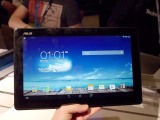
 Asus Transformer Book DuetThe Transformer Book Duet will have two options for its 13.3″ touchscreen display – 768p regular TFT or a 13.3″ IPS unit. You will be also able to pick between the latest Core i3, i5 and i7 Intel processors, 64 or 128GB SSD, while the amount of RAM is fixed at 4GB.The dock has lots of ports, a secondary HDD and, of course, a keyboard. But first things first.The Asus Transformer Book Duet's entire front is occupied by the 13.3-inch display of your choice – either an HD TFT or a Full HD IPS unit. There is nothing on the black frame but the video-call camera above the display.
Asus Transformer Book DuetThe Transformer Book Duet will have two options for its 13.3″ touchscreen display – 768p regular TFT or a 13.3″ IPS unit. You will be also able to pick between the latest Core i3, i5 and i7 Intel processors, 64 or 128GB SSD, while the amount of RAM is fixed at 4GB.The dock has lots of ports, a secondary HDD and, of course, a keyboard. But first things first.The Asus Transformer Book Duet's entire front is occupied by the 13.3-inch display of your choice – either an HD TFT or a Full HD IPS unit. There is nothing on the black frame but the video-call camera above the display.

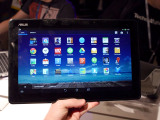 Asus Transformer Book Duet frontThe left side of the tablet has some cooling vents plus the full-sized SD slot. The right one is completely bare.
Asus Transformer Book Duet frontThe left side of the tablet has some cooling vents plus the full-sized SD slot. The right one is completely bare.
 Asus Transformer Book Duet left and right sidesThe bottom is quite crowded – there you can find the mandatory Win key, the docking ports, a 3.5mm audio jack and the small charging port.
Asus Transformer Book Duet left and right sidesThe bottom is quite crowded – there you can find the mandatory Win key, the docking ports, a 3.5mm audio jack and the small charging port.
 Asus Transformer Book Duet crowded bottom and bare topThe aluminum dock offers a keyboard with a dedicated dual-boot key. In case you are not using the dock, both operating systems offer a virtual key. Switching between Windows 8.1 and Android 4.2 Jelly Bean (or vice versa) takes about 4 seconds. The dock also packs a huge multi-touch pad.
Asus Transformer Book Duet crowded bottom and bare topThe aluminum dock offers a keyboard with a dedicated dual-boot key. In case you are not using the dock, both operating systems offer a virtual key. Switching between Windows 8.1 and Android 4.2 Jelly Bean (or vice versa) takes about 4 seconds. The dock also packs a huge multi-touch pad.

 Asus Transformer Book Duet keyboard dockThe dock offers Ethernet, HDMI, USB and a 3.5mm audio ports on the left side.
Asus Transformer Book Duet keyboard dockThe dock offers Ethernet, HDMI, USB and a 3.5mm audio ports on the left side.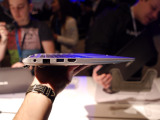

 Asus Transformer Book Duet keyboard dock • the virtual keys for switching between Windows and AndroidAs far as we understood, there is no extended battery within the docking station, but you can get it with a 320, 500, 750 GB or 1 TB additional HDD for expanding your storage space.The slate and the keyboard dock weigh 1.9 kilos. Pricing starts at $599 for the base version, but upgrades haven’t been detailed just yet. Availability hasn’t been confirmed either.
Asus Transformer Book Duet keyboard dock • the virtual keys for switching between Windows and AndroidAs far as we understood, there is no extended battery within the docking station, but you can get it with a 320, 500, 750 GB or 1 TB additional HDD for expanding your storage space.The slate and the keyboard dock weigh 1.9 kilos. Pricing starts at $599 for the base version, but upgrades haven’t been detailed just yet. Availability hasn’t been confirmed either.Asus Padfone mini hands-on
Alongside the trio of Zenfone devices, Asus released a new PadFone mini. Unlike the dual-SIM, Qualcomm-powered device with the same name which broke cover in December last year, the newcomer features Intel Atom SoC.


 Asus PadFone mini live photosThe new Asus PadFone mini consists of a compact smartphone with 4” WVGA IPS+ display and a docking station with a 7” screen of the same type. The handset is powered by a 1170mAh battery, while the docking station packs a 2100mAh unit.The device has an Intel Atom Z2560 CPU clocked at 1.6GHz. The rest of its specs include 8MP f/2.0 camera, 2MP front-facing unit, 1GB of RAM, 8GB of built in memory, microSD card slot, and Android 4.3 Jelly Bean with Asus ZenUI (Android 4.4 KitKat is planned).Connectivity options of the PadFone mini include GSM/GPRS/EDGE and WCDMA/HSPA+/DC-HSPA+. The last one supports download speeds of up to 42Mbps. Bluetooth 4.0 and Wi-Fi 802.11 b/g/n with Wi-Fi Direct are also on board.The measures of the Asus PadFone mini handset are 124.42 x 61.44 x 6.3-11.2mm, while the ones of the dock are 199.85 x 119.43 x 13.91mm. The phone and the docking station weigh 116g and 260g respectively.
Asus PadFone mini live photosThe new Asus PadFone mini consists of a compact smartphone with 4” WVGA IPS+ display and a docking station with a 7” screen of the same type. The handset is powered by a 1170mAh battery, while the docking station packs a 2100mAh unit.The device has an Intel Atom Z2560 CPU clocked at 1.6GHz. The rest of its specs include 8MP f/2.0 camera, 2MP front-facing unit, 1GB of RAM, 8GB of built in memory, microSD card slot, and Android 4.3 Jelly Bean with Asus ZenUI (Android 4.4 KitKat is planned).Connectivity options of the PadFone mini include GSM/GPRS/EDGE and WCDMA/HSPA+/DC-HSPA+. The last one supports download speeds of up to 42Mbps. Bluetooth 4.0 and Wi-Fi 802.11 b/g/n with Wi-Fi Direct are also on board.The measures of the Asus PadFone mini handset are 124.42 x 61.44 x 6.3-11.2mm, while the ones of the dock are 199.85 x 119.43 x 13.91mm. The phone and the docking station weigh 116g and 260g respectively.

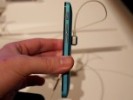




 The device is relatively compactThough we have no details available at the moment, the new Asus PadFone mini will be priced quite competitively. Therefore, it is no surprise that both the handset and its docking station feature a plastic build.
The device is relatively compactThough we have no details available at the moment, the new Asus PadFone mini will be priced quite competitively. Therefore, it is no surprise that both the handset and its docking station feature a plastic build.


 A closer look at the PadFone miniThe above said, both the tablet and its docking station look and feel solid when handled in person. Asus has a long history of building quality devices and the new PadFone mini is no exception – it is certain to handle plenty of daily use with no hiccups.We will pass a full verdict on the new Asus PadFone mini when we get a chance to fully review it. However, at a quick glance and depending on its pricing, the device looks like an appealing AIO budget alternative.
A closer look at the PadFone miniThe above said, both the tablet and its docking station look and feel solid when handled in person. Asus has a long history of building quality devices and the new PadFone mini is no exception – it is certain to handle plenty of daily use with no hiccups.We will pass a full verdict on the new Asus PadFone mini when we get a chance to fully review it. However, at a quick glance and depending on its pricing, the device looks like an appealing AIO budget alternative.



No comments:
Post a Comment